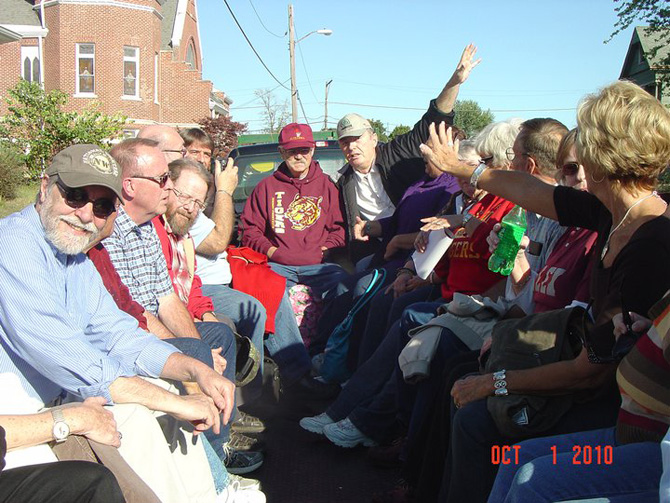Fall Waning Back to School Moon
Had no internet connection at camp Chesterfield.
October 1st, 2010 9 pm
Chesterfield Spiritualist Camp, Chesterfield Indiana Rm 219, The Western Hotel
Drove down from Lafayette taking interstates because I wanted to have time for a nap. Got here about 2 and took an hour long nap. The room is basic. A bed, a small chest of drawers, a lamp and a bathroom. No three pronged plugs and no internet. A retreat environment.
In Alexandria I saw Tim Lockwood and Mike Lynch hanging out in front of the Alexandria Historical Society. My folks. When I went inside there were about 15 people in the room, many of whom I didn’t recognize.
Teddy Bryant I did recognize. He told me about Saturday being the devil’s night, long ago. He’s a real estate agent now after a career as an electrician. “I had two careers, both of them I looked forward to going to work in the morning. Not many people can say that.”
Then, he added, “I have a bone to pick with you.” Huh. “One night after we got done with the truck at Coxes I walked over and asked Vicky Moore out. But. When I asked her again the next day, she said, Charlie told me what you said. She never went out with me.” Gee, Ted. A while ago. I don’t remember the incident or Vicky Moore for that matter.
Jay Kantner was there, short as ever with a beard and a hearing aid. He lives in Oregon, fishes the Columbia and hunts in the area. When I asked him if it was salmon, he said, “All five species.”
Larry Maple, the original organizer with Becky Ellis, looked pretty beat up. He had a bladder taken out and replace, then a swollen lymph gland that they just drained three weeks ago. He looks thin and weak.
Tony Fox came up and asked for her flowers and honey. I plain forgot. She hugged me to her now ample bosom and gave me a kiss.
After a bit more like that, they organized us for the homecoming parade. We had a float which consisted of a flat bed trailer with hay bales and a few chairs. About 20 of us got on and rode  through town doing the wave and old Alexandria Tigers cheers. Along the way we played remember what used to be there along Harrison Avenue, many of the store fronts are empty and only Cox’s Supermarket and Broyle’s furniture remain of the businesses from our childhood: The Rexall Drug Store, Danners, Murphys, PN Hirsch, Bailey’s pharmacy, Furman’s, Baumgartners, Mahoney’s.
through town doing the wave and old Alexandria Tigers cheers. Along the way we played remember what used to be there along Harrison Avenue, many of the store fronts are empty and only Cox’s Supermarket and Broyle’s furniture remain of the businesses from our childhood: The Rexall Drug Store, Danners, Murphys, PN Hirsch, Bailey’s pharmacy, Furman’s, Baumgartners, Mahoney’s.
It was fun and bittersweet, being with old friends, childhood friends, sharing memories but noticing that this was our 45th reunion, lots of gray hair, 20% of the class now dead.
After the parade wound its way out to the newer Alexandria High School, Larry Etchison drove us back into town. We got our cars and drove out to the curve. I saw Bill Kildow. Geez. Been a real long time. His brother, Steve, was in my class, but Bill and I had a special bond. It was good to see him. The Kildow’s lived on Monroe Street in the late 50’s and so did I.
We sat around swapping stories. Where do you live now? What do you do? Any grandkids? You have great grandchildren! Louie Bender, extroverted as ever, went up and hugged a woman, said, “Tamara, Don’t you remember me? Louis Bender.” It wasn’t Tamara.
October 2nd. A laundromat across from what used to be the Roller Rink, at one time the best in the nation and site of national competitions. Now it’s an Eagles. The only skating is, as someone said last night, “after there’s been a lot of drinking.”
Breakfast this morning at the Maxon cafeteria, just across from the Western Hotel. It serves guests and residents of Chesterfield. At the table I talked with two women, professors of Spanish and Spanish Literature at Depauw, one from Colombia and the other from Argentina, Buenos Aires. They had a similar reaction to the Camp, about which they’d known nothing before they got there. It’s a great setting for a book, like being back in the 19th century, down to the little floral decals on the light bulb holder in the bathroom.
“I’m interested in how people form their worlds,” I said, “And this is a particular world. We all have them, but here the line are so clear.” After I said that, I realized it was exactly what I’m interested in, how people form, give definition to their weltenschaung. How do you become and sustain a belief in spiritualism, in the non-physical plane? You have to ignore or explain away a lot of evidence to the contrary.
After breakfast, it was back to the Alexandria Historical Society for coffee and another meet up. I looked at a 1965 spectrum, our yearbook. Gee, it was a long time ago. A lot of things were different back then. I had hair. Juvenile delinquency was a problem. Remember j.d.’s? How innocent, almost quaint they seem in light of rap music, meth and general ornerynesss of our time.
Steve Kildow had a huge tent with catered food and lots of booze. A lot folks were there including Jerry Ferguson, who looked a lot different, enough that I didn’t recognize him. Steve lives two miles west of town off Hwy 28, a big spread with a fancy house and lots of horses. Steve looks like he enjoys his groceries.
Now I’m at the laundromat, getting enough clean clothes together for the rest of the trip. I decided to spend this time to pack a bit—a lot—lighter. I’m glad I did. Well, the dryers are coming to a stop and I have folding and rolling to do.

 He kept me company while I picked the ripe red and golden fruit. He waited yet longer while I got Kate. He waited even longer when I went back inside and got the camera.
He kept me company while I picked the ripe red and golden fruit. He waited yet longer while I got Kate. He waited even longer when I went back inside and got the camera.